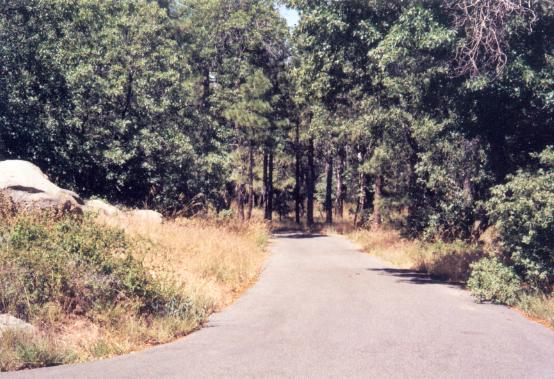
Sunset, seen from the catwalk of the 40-inch telescope, heralds another perfect night. Fog in the valley smothers the lights from the city.

The 40-inch telescope begain service on Mount
Laguna in 1981. Its state-of-the-art CCD 2001 camera, inside the
cylindrical gold Dewar, was made in the CCD Laboratory at San
Diego State.

Fresno State student Dan Chase opens the 40-inch
telescope's dome at the beginning of the night.

San Diego State Professor of Astronomy Bill
Welsh, in the control room of the 40-inch telescope, observes a
gravitational microlensing event.

In front of Harrington Visitors' Center, on
Mount Laguna

The trail up to the 21-inch telescope

Approaching the 21-inch telescope

The 21-inch telescope is used primarily for
educational eyepiece observing by students.

The deck around the 21-inch telescope has a
sundial, at right.

The view from the 21-inch telescope's deck

Going back down to the Harrington Visitors'
Center

Passing the Harrington Visitors' Center, with
the museum at far right and the classroom at center

The trail to the 40-inch telescope

Approaching the 40-inch telescope

The 40-inch telescope is the primary science
instrument at Mount Laguna Observatory.

Passing the 40-inch telescope, approaching
the machine shop

Mount Laguna Observatory has this fully equipped
machine shop.

The dormitory at Mount Laguna Observatory, a
stalwart structure with thick concrete walls, is fine for day sleepers.

The dorm's library is where astronomers pass
occasional cloudy nights.

The 16-inch telescope's dome is being renovated
to house the new 1-m ULTRA telescope.

The view from next to the 16-inch
telescope's dome

The trail to the 24-inch telescope

Approaching the 24-inch telescope

The dome of the 24-inch telescope

Fresno State student Dan Chase in front of the
dome of the 24-inch telescope. To the right is the summit of Mount Laguna,
planned home for a 3-m robotic telescope, the largest in the world. On it
now is the NSF-funded High Performance Wireless Research and Education
Network (HPWREN), the microwave data link between the observatory and San
Diego State University's campus.

The view from the summit of Mount Laguna

The trail down from the summit of Mount
Laguna

Further down the trail, approaching the
dorm

This view from near the campground, futher down
Mount Laguna, shows one reason Mount Laguna is such a fine observatory site:
the haze layer is trapped below the observatory by a temperature
inversion.